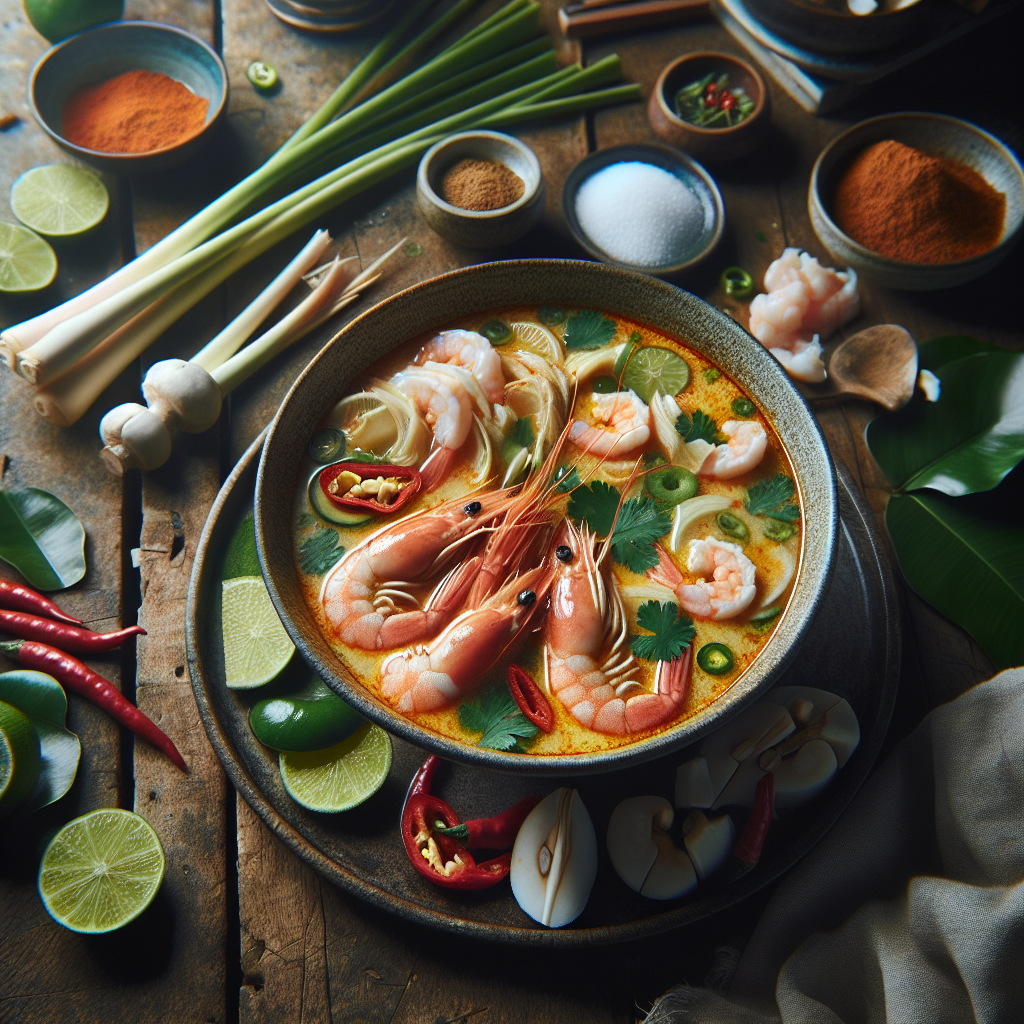
Transport your taste buds to Thailand with this aromatic and creamy Tom Yum Goong soup. This restaurant-quality coconut shrimp soup perfectly balances spicy, sour, and sweet flavors, featuring succulent shrimp, fragrant lemongrass, and rich coconut milk.
Ingredients for Authentic Tom Yum Goong: Spicy Thai Coconut Shrimp Soup Recipe
- 14oz Raw Shrimp (peeled and deveined)
- 14oz Coconut Milk
- 25oz Chicken Stock
- 2stalks Lemongrass Stalks (bruised and cut into 4-inch pieces)
- 1oz Fresh Ginger (sliced)
- 4leaves Lime Leaves
- 2chilies Red Thai Chili (sliced)
- 2 tbsp Fish Sauce
- 3 tbsp Lime Juice
- 1 tbsp Brown Sugar
- 7oz Fresh Mushrooms (sliced)
- 0.5oz Fresh Cilantro (chopped)
Instructions for Authentic Tom Yum Goong: Spicy Thai Coconut Shrimp Soup Recipe
- In a large pot, combine 25oz chicken stock, 14oz coconut milk, lemongrass, ginger, and lime leaves. Bring to a simmer over medium heat.
- Add 7oz sliced mushrooms and 2chilies Thai chilies. Simmer for 5 minutes.
- Add 14oz raw shrimp to the soup and cook for 3-4 minutes until they turn pink.
- Stir in 2 tbsp fish sauce, 3 tbsp lime juice, and 1 tbsp brown sugar. Simmer for another 2 minutes.
- Remove lemongrass stalks, ginger slices, and lime leaves from the soup.
- Garnish with 0.5oz fresh cilantro and serve hot.
Discover the Magic of Tom Yum Goong: A Thai Soup That Warms the Soul
As a chef who grew up straddling two culinary worlds, I've always been fascinated by dishes that tell a story, and Tom Yum Goong is a masterpiece that speaks volumes. This iconic Thai soup, with its perfect harmony of spicy, sour, and creamy elements, has become a globally celebrated dish that captures the essence of Thai cuisine. Made with plump shrimp, aromatic lemongrass, and velvety coconut milk, this soup is a symphony of flavors that dance on your tongue.
What makes this version of Tom Yum Goong special is its creamy variation, known as Tom Yum Nam Khon, which includes coconut milk for added richness. In just 40 minutes total (15 minutes prep, 25 minutes cooking), you'll create a restaurant-quality soup that serves 4 people and delivers both comfort and excitement in every spoonful. With 320 calories per serving, it's a satisfying main course that doesn't weigh you down.
Essential Tips for Perfect Tom Yum Goong Every Time
The secret to exceptional Tom Yum Goong lies in the details. First, don't skip the bruising of your lemongrass - this releases the essential oils that give the soup its signature aroma. I like to use the back of my knife to gently crush the stalks before cutting them into pieces.
When it comes to the shrimp, freshness is key. Look for shrimp that are firm and smell like the ocean - not fishy. While the recipe calls for 14 oz (400g) of shrimp, you can adjust this amount based on your preference. Just make sure not to overcook them; 3-4 minutes is perfect for maintaining their succulent texture.
For the coconut milk, always shake the can well before opening. If you see separation, that's normal - just make sure to incorporate it fully into the soup. And here's a pro tip: add the lime juice at the very end to maintain its bright flavor. If you add it too early, the heat will dull its zesty punch.
Serving Your Tom Yum Goong with Style
Tom Yum Goong is best enjoyed piping hot, served in deep bowls that allow the aromatics to gather and create that wonderful first impression when the bowl reaches the table. I like to serve it with a side of jasmine rice (khao suay), which helps temper the heat and soak up the flavorful broth.
For garnishing, don't just sprinkle the cilantro (0.5 oz/15g) on top - tear it with your hands to release its aromatic oils. Additional fresh lime wedges on the side allow guests to adjust the sourness to their liking. For those who enjoy extra heat, provide some fresh sliced Thai chilies or chili oil on the side.
From My Grandmother's Kitchen to Yours: A Tom Yum Tale
My journey with Tom Yum Goong began in my grandmother's humble kitchen in Bangkok. I remember standing on a small wooden stool, barely tall enough to see over the pot, watching her orchestrate what seemed like magic. She would taste the soup repeatedly, adjusting the fish sauce, lime juice, and chilies until she achieved what she called "the dance of flavors."
Years later, when I opened my first restaurant in America, I was determined to recreate that same magic. It took dozens of attempts to perfect the balance she had achieved so effortlessly. The moment I finally got it right, the aroma transported me right back to that kitchen, standing on that wooden stool. This recipe is a tribute to her teachings - a perfect blend of tradition and accessibility that brings authentic Thai flavors to your home kitchen.
Smart Substitutions for Your Tom Yum Goong
Making this classic Thai soup but missing some ingredients? No worries! As someone who's been cooking Thai food for years, I can share some tested substitutions that'll keep the essence of Tom Yum Goong intact:
For the proteins:
- Shrimp (14 oz/400g): Use scallops, firm white fish, or even chicken. For vegetarians, firm tofu or king oyster mushrooms work wonderfully
- For vegans, double up on mushrooms and add some bamboo shoots for extra texture
For the aromatics:
- Lemongrass: If you can't find fresh, use 2 tablespoons of lemongrass paste. In a pinch, combine 1 tablespoon of lemon zest with a small pinch of ginger
- Kaffir lime leaves: Substitute with 1 tablespoon of lime zest or 2 bay leaves plus some lime zest
- Fresh ginger (1 oz/30g): Galangal is actually more traditional, but ginger is easier to find. You can use 1 tablespoon of ginger paste as well
For the liquids:
- Coconut milk (14 oz/400ml): Light coconut milk works fine for a lighter version. For dairy-free alternatives without coconut, use cashew cream
- Chicken stock (25 oz/750ml): Vegetable stock works perfectly for a vegetarian version. Fish stock adds extra seafood flavor
- Fish sauce (2 tbsp): Soy sauce or coconut aminos work, though you'll miss some of that unique umami. Add a splash of Worcestershire sauce for depth
For the mushrooms (7 oz/200g):
- Any mushroom variety works: shiitake, button, cremini, or oyster mushrooms
- Mix different types for more interesting textures
Remember, while these substitutions work, each will slightly alter the final taste. The key is maintaining the balance of hot, sour, sweet, and salty that makes Tom Yum Goong so special.
Complete Nutrition Breakdown of Tom Yum Goong
As a chef focused on healthy cooking, I'm excited to share that Tom Yum Goong isn't just delicious – it's nutritious too! Here's the complete breakdown per serving (recipe serves 4):
Calories: 320 kcal
- Total Fat: 22g
- Saturated Fat: 18g (primarily from coconut milk)
- Unsaturated Fat: 4g
- Total Carbohydrates: 15g
- Dietary Fiber: 2g
- Sugar: 6g
- Protein: 24g
- Sodium: 890mg
- Potassium: 450mg
- Vitamin C: 35% DV
- Iron: 15% DV
- Calcium: 8% DV
This soup is particularly nutritious because:
- Shrimp provides high-quality protein and iodine
- Coconut milk offers healthy fats and minerals
- Lemongrass contains antioxidants and anti-inflammatory compounds
- Mushrooms provide immune-boosting properties and vitamin D
- Ginger and chilies boost metabolism and aid digestion
- Lime juice adds vitamin C and aids in iron absorption
For those watching their calories, you can reduce the fat content by:
- Using light coconut milk (reduces calories to about 250 per serving)
- Increasing the ratio of broth to coconut milk
- Adding more vegetables like bell peppers or bamboo shoots
Important Allergy Information for Thai Tom Yum Goong
As someone who regularly cooks for people with various dietary restrictions, I want to ensure everyone can enjoy this Thai classic safely. Here are the major allergens and concerns to be aware of:
Common Allergens Present:
- Shellfish (shrimp)
- Fish (in fish sauce)
- Potential mushroom sensitivities
- Coconut (technically a tree nut by FDA classification)
Hidden Ingredients to Watch:
- Some commercial fish sauces may contain wheat
- Store-bought chicken stock might contain celery or soy
- Pre-packaged lemongrass paste may include preservatives
This Recipe is:
- Gluten-free (when using GF fish sauce and stock)
- Dairy-free
- Egg-free
- Peanut-free
- Tree nut-free (except coconut)
Modifications for Common Allergies:
- Shellfish allergy: Replace shrimp with tofu or chicken
- Fish sauce allergy: Use coconut aminos or soy sauce
- Coconut allergy: Use dairy-free cream alternative
- Mushroom sensitivity: Skip or replace with bamboo shoots
Always check ingredient labels and when serving to others, clearly communicate the presence of these allergens.
Storage Tips for Your Tom Yum Goong
Proper storage is crucial for maintaining the vibrant flavors of this Thai soup. Here's how to keep your Tom Yum Goong fresh and delicious:
Immediate Storage:
- Cool the soup completely before refrigerating
- Store in an airtight container
- Refrigerator: Keeps for 3-4 days
- Freezer: Maintains quality for up to 3 months
Best Practices:
- Remove lemongrass, lime leaves, and ginger pieces before storing
- Store fresh cilantro separately
- If freezing, slightly undercook the shrimp to prevent them from becoming rubbery when reheated
Reheating Instructions:
- Stovetop: Heat slowly on medium-low, stirring occasionally
- Microwave: Use 50% power in 1-minute intervals, stirring between
- Add fresh herbs only after reheating
- If soup becomes too thick, thin with a bit of chicken stock
For Meal Prep:
- Prepare the broth base without shrimp
- Freeze in portion-sized containers
- Add fresh shrimp when reheating
Frequently Asked Questions About Tom Yum Goong
As a chef who teaches Thai cooking, here are the most common questions I receive about making Tom Yum Goong:
Q: Can I make this less spicy? A: Absolutely! Reduce or omit the Thai chilies. The soup's flavor comes from many components, not just heat.
Q: Where can I find lemongrass and lime leaves? A: Asian markets typically stock these. Some larger supermarkets carry them in the produce section. Check the freezer section too.
Q: Is Tom Yum Goong healthy? A: Yes! It's protein-rich and filled with immune-boosting ingredients like lemongrass, ginger, and chilies.
Q: Can I make this in advance for a party? A: Prepare the broth base ahead, but add shrimp just before serving for best results.
Q: Why did my coconut milk curdle? A: This happens when boiling too vigorously. Simmer gently and stir occasionally to prevent separation.
Q: How do I achieve the right balance of flavors? A: Start with the recipe amounts, then adjust: more lime for sourness, sugar for sweetness, fish sauce for saltiness, and chilies for heat.
Bringing Thai Flavors Home with Tom Yum Goong
Creating this authentic Tom Yum Goong takes you on a journey through the heart of Thai cuisine. The combination of succulent shrimp, aromatic lemongrass, spicy chilies, and creamy coconut milk creates a symphony of flavors that's both comforting and exciting.
What makes this soup special is its versatility – it can be adjusted to your taste preferences while maintaining its authentic character. Whether you're serving it as a starter or main course, Tom Yum Goong never fails to impress with its vibrant flavors and aromatic presence.
Remember, the key to success lies in balancing the four fundamental Thai tastes: sour from lime, salt from fish sauce, sweet from brown sugar, and heat from chilies. Don't be afraid to adjust these elements to suit your palate.
As we say in Thai cooking, this soup should make you say "aroi" (delicious) with every spoonful. Give it a try, and you'll see why Tom Yum Goong has become a beloved dish worldwide, bringing a taste of Thailand to kitchens across the globe.
